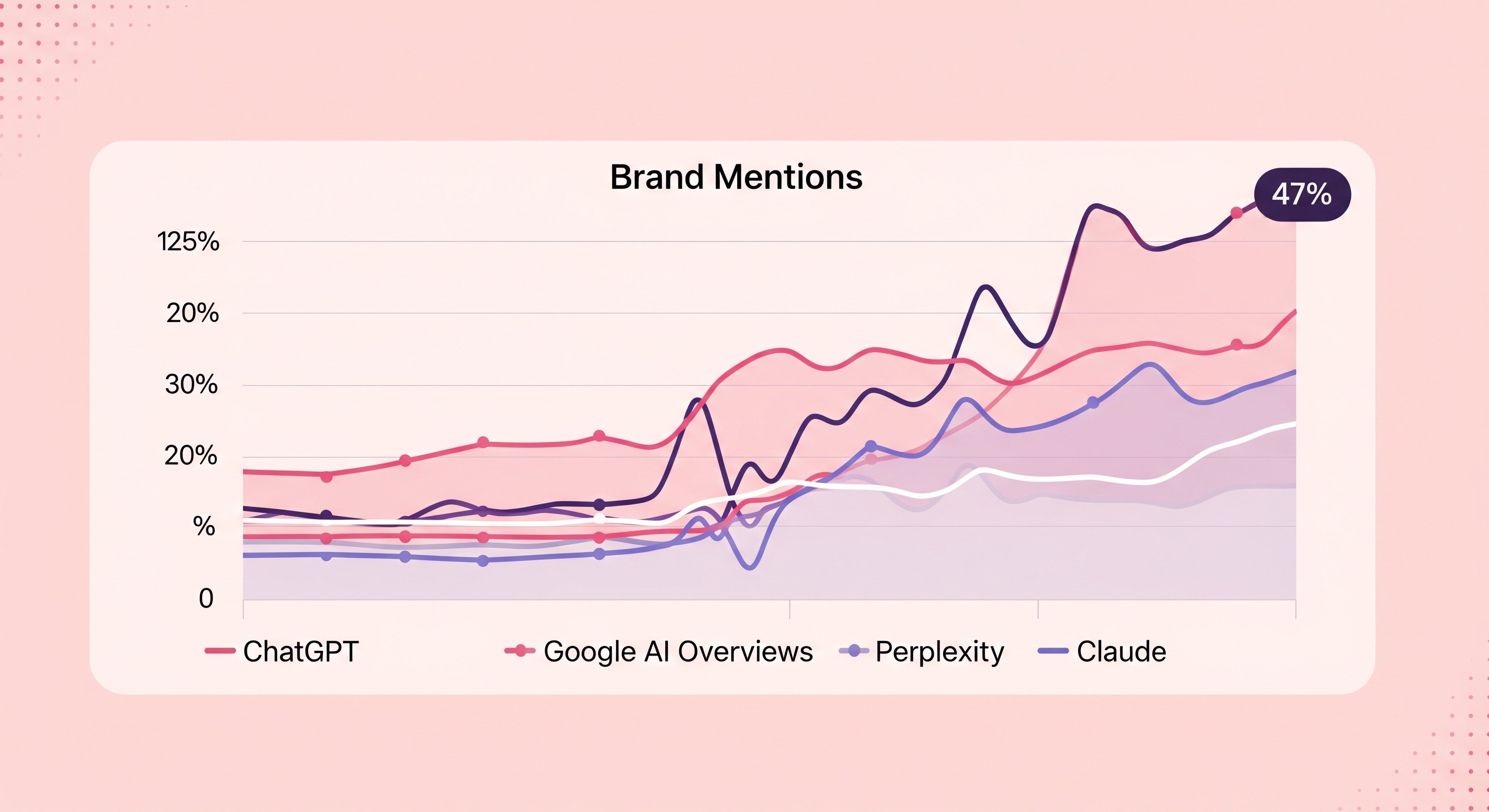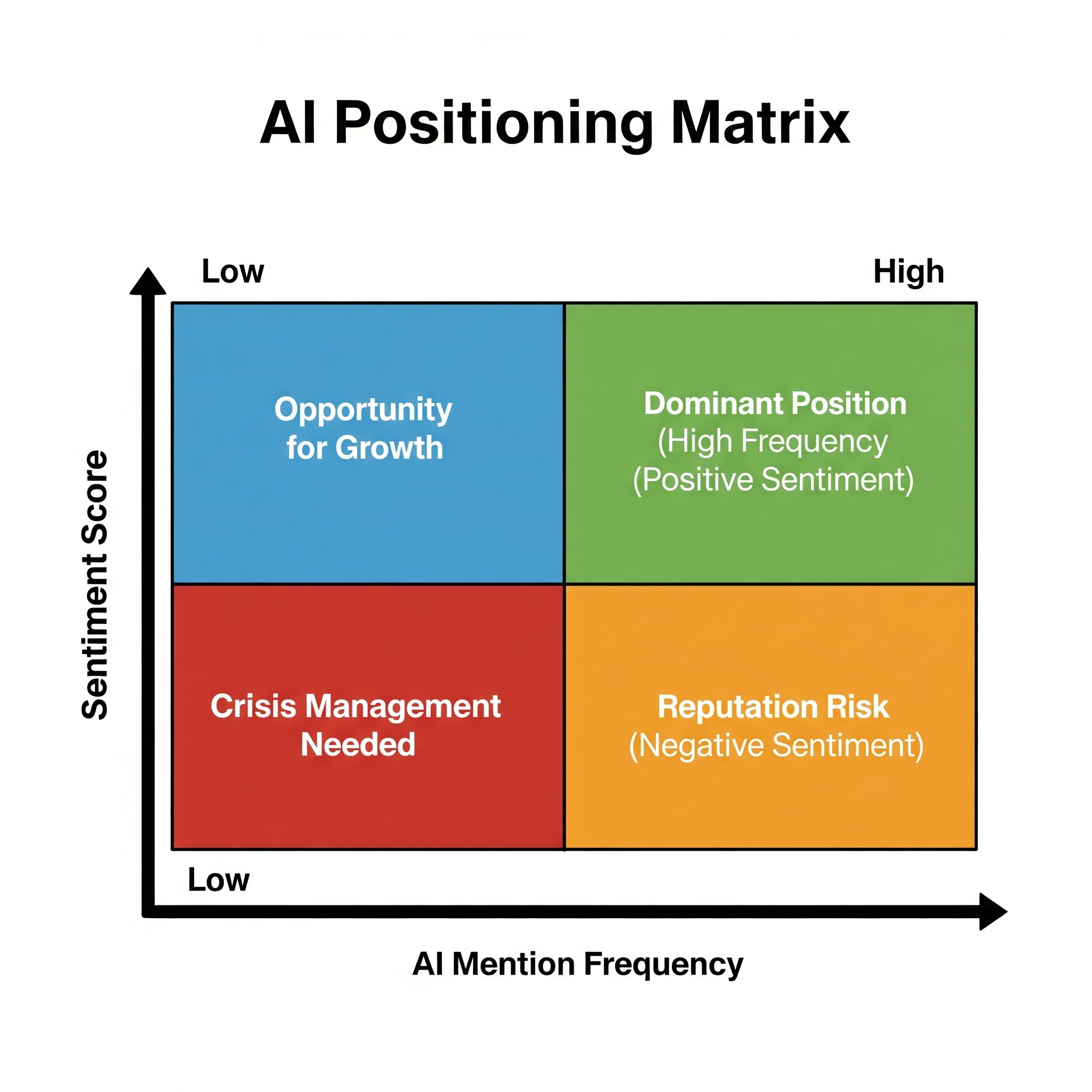
How to Benchmark Brand Visibility Against Competitors in Generative AI Responses
In the traditional SEO world, competitive intelligence meant tracking keyword rankings, backlinks, and content strategies. But in the AI era, the rules have completely changed.
Your competitors might be dominating traditional search results, but are they visible in AI-generated responses? Are they mentioned favorably in ChatGPT recommendations? Do they appear in Google AI Overviews?
This is the new competitive battlefield—and most brands aren't even aware they're losing.
In this guide, we'll explore how to benchmark brand visibility against competitors in generative AI responses, such as ChatGPT, Gemini, Perplexity, etc, leverage AI visibility data for competitive insights, and uncover strategic opportunities to strengthen your brand's position in the AI-driven discovery landscape.
The New Era of Competitive Intelligence: Benchmarking in GenAI Responses
From Keyword Rankings to AI Mentions
Traditional competitive intelligence focused on:
- Keyword ranking positions
- Organic traffic volumes
- Backlink profiles
- Content publishing frequency
AI-era competitive intelligence focuses on:
- Brand mention frequency in AI responses
- Share of voice across AI platforms
- Sentiment and positioning in AI answers
- Topic-level AI visibility gaps
Why AI Visibility Intelligence Matters More
When users ask AI assistants for recommendations, only a few brands get mentioned. If your competitor is consistently recommended by ChatGPT while you're not, you're losing potential customers without even knowing it.
Example: A user asks ChatGPT "What's the best email marketing tool for e-commerce?" If Mailchimp gets mentioned 80% of the time and your brand gets mentioned 20%, you have a significant competitive disadvantage.
Key Metrics to Benchmark Brand Visibility in Generative AI
1. AI Share of Voice (SOV)
What it measures: The percentage of AI responses in your category that mention your brand vs. competitors.
Why it matters: Higher AI SOV correlates with increased brand awareness and consideration in AI-driven purchase decisions.
How to track: Monitor mentions across ChatGPT, Google AI Overviews, Perplexity, and other AI platforms. Use Seonali to benchmark your brand visibility
2. AI Response Sentiment Analysis
What it measures: How positively or negatively your brand is positioned in AI-generated responses.
Why it matters: Even if you're mentioned frequently, negative positioning can hurt your brand perception.
Key metrics:
- Positive vs. negative mentions
- Comparative positioning
- Feature highlighting
- Price positioning
3. Topic-Level AI Visibility
What it measures: Which specific topics, use cases, and personas trigger brand mentions in AI responses.
Why it matters: Understanding your AI visibility gaps helps you optimize content and positioning.
Example: Your brand might be strong for "enterprise solutions" but weak for "small business tools" in AI responses.
4. Cross-Platform AI Presence
What it measures: How consistently your brand appears across different AI platforms.
Why it matters: Different AI platforms serve different user segments and use cases.
Platforms to monitor:
- ChatGPT (general recommendations)
- Google AI Overviews (search-driven)
- Perplexity (research-focused)
- Claude (detailed analysis)
How Seonali Helps You Benchmark Brand Presence in AI Outputs
Seonali offers comprehensive AI competitive intelligence capabilities:
✅ Real-Time Competitor Monitoring
Track your competitors' AI visibility across multiple platforms and identify trends over time.
✅ Share of Voice Analysis
See exactly how your AI visibility compares to competitors in your category.
✅ Sentiment Comparison
Understand how your brand positioning differs from competitors in AI responses.
✅ Topic Gap Analysis
Identify topics where competitors are strong but you're weak in AI visibility.
✅ Persona-Based Intelligence
See how different user personas trigger different AI responses about your brand vs. competitors.
Case Study: Benchmarking Brand Visibility Against Competitors in GenAI
Let's examine how a SaaS company used AI competitive intelligence to gain market share:
The Situation
Company: A project management tool competing with Asana, Trello, and Monday.com
Problem: Strong traditional SEO rankings but poor AI visibility
Goal: Increase AI mention frequency and improve competitive positioning
The AI Competitive Analysis
Using Seonali, they discovered:
AI Share of Voice:
- Asana: 45% of AI responses
- Monday.com: 30% of AI responses
- Trello: 15% of AI responses
- Their brand: 10% of AI responses
Key Insights:
- Asana dominated "enterprise project management" mentions
- Monday.com was strong for "visual project management"
- Trello excelled at "simple task management"
- Their brand was rarely mentioned for any use case
Sentiment Analysis:
- Asana: "Professional and feature-rich"
- Monday.com: "Visual and intuitive"
- Trello: "Simple and easy to use"
- Their brand: Minimal mentions, neutral sentiment
The Strategy
Based on AI competitive intelligence, they:
- Identified a gap: No brand dominated "agile project management" in AI responses
- Repositioned content: Focused on agile methodologies and sprint planning
- Optimized for AI consumption: Created comprehensive guides on agile project management
- Built thought leadership: Published authoritative content on agile best practices
The Results
After 6 months:
- AI Share of Voice increased from 10% to 25%
- Became the top-mentioned brand for "agile project management"
- Improved sentiment from neutral to "agile-focused and efficient"
- Increased organic traffic by 40% from AI-driven discovery
Frameworks for Strategic Brand Benchmarking in Generative AI
1. The AI Visibility Gap Analysis
Step 1: Map your competitors' AI visibility across key topics Step 2: Identify topics where you're weak but competitors are strong Step 3: Find topics where no competitor dominates Step 4: Prioritize opportunities based on market size and difficulty
2. The AI Positioning Matrix

X-axis: AI mention frequency Y-axis: Sentiment score Quadrants:
- High frequency, positive sentiment: Dominant position
- High frequency, negative sentiment: Reputation risk
- Low frequency, positive sentiment: Opportunity for growth
- Low frequency, negative sentiment: Crisis management needed
3. The AI Platform Strategy
Different AI platforms serve different purposes:
- ChatGPT: General recommendations and comparisons
- Google AI Overviews: Search-driven discovery
- Perplexity: Research and detailed analysis
- Claude: In-depth explanations and comparisons
Strategy: Optimize for platforms that align with your target audience and use cases.
Advanced Techniques to Measure AI Generated Brand Mentions
1. Predictive AI Visibility Modeling
Use historical AI visibility data to predict future trends and competitor moves.
Example: If a competitor's AI mentions are declining, they might be shifting strategy or losing relevance.
2. Content Attribution Analysis
Identify which content pieces are driving your competitors' AI visibility and reverse-engineer their strategy.
Example: If a competitor is frequently mentioned for "enterprise features," analyze their enterprise-focused content.
3. Persona-Based Competitive Analysis
Understand how different user segments trigger different AI responses about your brand vs. competitors.
Example: Your brand might be strong for "startup founders" but weak for "enterprise buyers" in AI responses.
4. Seasonal AI Visibility Patterns
Track how AI visibility changes over time and identify seasonal opportunities.
Example: E-commerce brands might see increased AI mentions during holiday seasons.
Actionable Strategies to Boost Your Brand’s GenAI Visibility
Immediate Actions (Next 30 Days)
- Conduct AI competitive audit using Seonali
- Identify top 3-5 competitors and their AI presence
- Map AI visibility gaps in your category
- Analyze competitor content driving AI mentions
Short-Term Strategy (1-3 Months)
- Develop AI-optimized content for identified gaps
- Reposition brand messaging based on AI sentiment analysis
- Build thought leadership in underserved topics
- Monitor competitor moves and respond quickly
Long-Term Strategy (3-12 Months)
- Establish AI-first competitive advantage
- Build sustainable AI visibility across platforms
- Create competitive moats through unique positioning
- Develop predictive intelligence capabilities
Common Mistakes When Benchmarking Brand Visibility in AI Responses
1. Focusing Only on Traditional Metrics
Mistake: Relying solely on keyword rankings and organic traffic Solution: Balance traditional SEO with AI visibility metrics
2. Ignoring Sentiment Analysis
Mistake: Only tracking mention frequency, not quality Solution: Monitor both frequency and sentiment of AI mentions
3. Single-Platform Focus
Mistake: Only monitoring one AI platform Solution: Track visibility across multiple AI platforms
4. Reactive vs. Proactive Intelligence
Mistake: Only responding to competitor moves Solution: Use AI intelligence to predict and prevent competitive threats
What’s Next for Brand Visibility and Competitive Intelligence in GenAI
AI-Powered Predictive Analytics
Advanced AI models will predict competitor moves and market shifts before they happen.
Real-Time Competitive Monitoring
Instant alerts when competitors gain or lose AI visibility will become standard.
Automated Competitive Response
AI systems will automatically suggest and implement competitive responses.
Cross-Platform Intelligence Integration
Unified dashboards combining traditional and AI competitive intelligence.
Conclusion: Winning the Brand Visibility Battle in Generative AI
The AI era has fundamentally changed competitive intelligence. Brands that master AI visibility monitoring and competitive analysis will gain significant advantages over those still focused on traditional metrics.
Key Success Factors:
- Comprehensive AI monitoring across multiple platforms
- Sentiment and positioning analysis beyond just mention frequency
- Proactive competitive intelligence rather than reactive responses
- Data-driven strategic decisions based on AI visibility insights
Whether you're a startup looking to disrupt established players or an enterprise defending market share, AI competitive intelligence is no longer optional—it's essential for survival and growth.
Ready to gain the AI competitive advantage? Start monitoring your competitors' AI visibility today with Seonali's comprehensive competitive intelligence platform.
The future belongs to brands that can see, understand, and act on AI visibility data faster than their competitors. Will you be one of them?